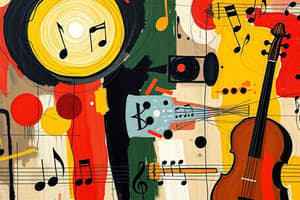Podcast
Questions and Answers
Which of the following is not a type of scale in music theory?
Which of the following is not a type of scale in music theory?
- Major scale
- Minor scale
- Binary scale (correct)
- Whole tone scale
Atonality refers to music that has a clear tonal center.
Atonality refers to music that has a clear tonal center.
False (B)
Name one influential figure in the genre of jazz music.
Name one influential figure in the genre of jazz music.
Louis Armstrong
In music theory, a _____ is a combination of three or more notes played together.
In music theory, a _____ is a combination of three or more notes played together.
What is the main characteristic of minimalism in music?
What is the main characteristic of minimalism in music?
Match the following composers to their notable contributions:
Match the following composers to their notable contributions:
The rise of punk music was characterized by adherence to mainstream trends.
The rise of punk music was characterized by adherence to mainstream trends.
What technological advancements had a significant impact on music production in the 20th century?
What technological advancements had a significant impact on music production in the 20th century?
Flashcards are hidden until you start studying
Study Notes
MAPEH: Music Theory in the 20th Century
Key Concepts in Music Theory
- Fundamentals of Music Theory
- Notes and Notation: Staff, clefs, note values (whole, half, quarter, eighth).
- Scales: Major, minor, chromatic, and whole tone scales.
- Intervals: Perfect, major, minor, augmented, and diminished intervals.
- Chords: Triads, seventh chords, extended chords.
- Harmony: Consonance vs. dissonance; diatonic and chromatic harmony.
- Rhythm: Time signatures, beat, tempo, syncopation.
Characteristics of 20th Century Music
-
Diversity in Styles
- Emergence of various genres: Jazz, rock, electronic, and hip-hop.
- Blend of classical and popular styles; cross-genre experimentation.
-
Innovative Compositional Techniques
- Atonality: Music without a tonal center, pioneered by composers like Arnold Schoenberg.
- Serialism: Use of series to organize pitches, rhythms, dynamics; associated with Schoenberg and Webern.
- Minimalism: Repetitive motifs, gradual change; notably used by Steve Reich and Philip Glass.
-
Use of Technology
- Introduction of electronic instruments: Synthesizers, drum machines.
- Sampling and digital recording techniques revolutionized production.
-
Influential Movements
- Jazz Age: Rise of jazz as a dominant musical form; improvisation and swing.
- Rock and Roll: Cultural impact in the 1950s and 1960s; artists like Elvis Presley and The Beatles.
- Punk and Alternative: Reaction against mainstream music; DIY ethos.
-
Global Influence
- Incorporation of world music elements: Reggae, Afrobeat, and traditional folk influences.
- Cross-cultural collaborations and fusion genres.
Notable Composers and Artists
-
Classical Composers
- Igor Stravinsky: Known for "The Rite of Spring."
- Benjamin Britten: Key figure in English opera and song.
-
Jazz and Popular Music Icons
- Louis Armstrong: Pioneering jazz trumpeter and vocalist.
- Bob Dylan: Influential singer-songwriter, merging poetry with music.
-
Contemporary Figures
- Philip Glass: Prominent minimalist composer.
- Kendrick Lamar: Influential voice in modern hip-hop.
Summary
The 20th century was marked by significant changes in music theory and styles, characterized by diverse genres, innovative techniques, and the integration of technology. The era saw the rise of influential composers and artists who pushed boundaries and created new musical landscapes.
Key Concepts in Music Theory
- Fundamentals of Music Theory: Essential components include notes, notation (staff, clefs), various note values (whole, half, quarter, eighth), major/minor/chromatic/whole tone scales, and different intervals (perfect, major, minor, augmented, diminished).
- Chords: Basic triads, seventh chords, and extended chords form the backbone of harmonic structure.
- Harmony: Distinctions between consonance (pleasant sound) and dissonance (tension); types of harmony include diatonic (within a key) and chromatic (not limited to one key).
- Rhythm: Involves understanding time signatures, beat, tempo, and the concept of syncopation which emphasizes off-beat accents.
Characteristics of 20th Century Music
- Diversity in Styles: This era experienced the emergence of genres such as jazz, rock, electronic music, and hip-hop, showcasing a blend of classical and popular styles.
- Innovative Compositional Techniques:
- Atonality lacks a tonal center, with Arnold Schoenberg as a key pioneer.
- Serialism organizes musical elements through a series, commonly linked with composers like Schoenberg and Anton Webern.
- Minimalism features repetitive motifs and gradual transformation, as represented by composers like Steve Reich and Philip Glass.
- Use of Technology: Electronic instruments like synthesizers and drum machines transformed music production; advancements in sampling and digital recording revolutionized how music is created.
Influential Movements
- Jazz Age: Jazz emerged as a dominant musical form, celebrated for its improvisation and swing style.
- Rock and Roll: This genre gained cultural significance during the 1950s and 1960s, influencing artists such as Elvis Presley and The Beatles.
- Punk and Alternative: Originated as a counter-movement against mainstream music, emphasizing a do-it-yourself (DIY) approach.
Global Influence
- World Music Elements: Integration of reggae, Afrobeat, and various traditional folk influences broadened music's scope.
- Cross-Cultural Collaborations: Fusion genres developed through collaboration among artists from different musical backgrounds.
Notable Composers and Artists
- Classical Composers:
- Igor Stravinsky, famed for "The Rite of Spring," reshaped modern music.
- Benjamin Britten is recognized as a prominent figure in English opera.
- Jazz and Popular Music Icons:
- Louis Armstrong is a pioneering figure in jazz, known for his trumpet playing and vocal style.
- Bob Dylan, a key singer-songwriter, effectively fused poetry with music.
- Contemporary Figures:
- Philip Glass is noted for his minimalist compositions.
- Kendrick Lamar is a leading voice in modern hip-hop, pushing artistic and lyrical boundaries.
Studying That Suits You
Use AI to generate personalized quizzes and flashcards to suit your learning preferences.




